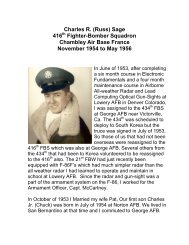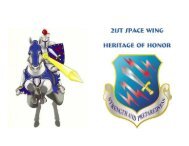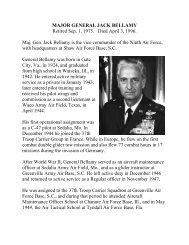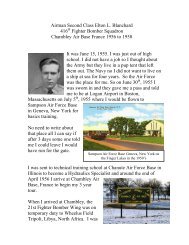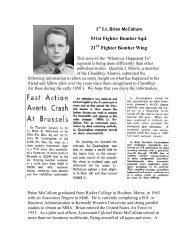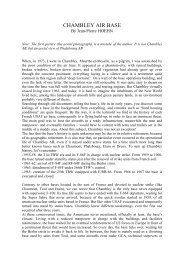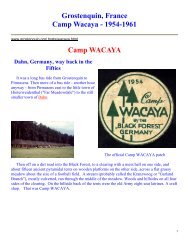DR. DAVID L. BULLOCK 21st Space Wing/History Office 775 Loring ...
DR. DAVID L. BULLOCK 21st Space Wing/History Office 775 Loring ...
DR. DAVID L. BULLOCK 21st Space Wing/History Office 775 Loring ...
Create successful ePaper yourself
Turn your PDF publications into a flip-book with our unique Google optimized e-Paper software.
Activation of the <strong>21st</strong> <strong>Space</strong> <strong>Wing</strong><br />
Gen Donald J. Kutyna (left), commander, Air Force <strong>Space</strong><br />
Command, inactivated the 1st <strong>Space</strong> <strong>Wing</strong> and 3d <strong>Space</strong> Support<br />
<strong>Wing</strong> on 15 May 1992. In attendance: 1st <strong>Space</strong> <strong>Wing</strong><br />
commander Col Thomas J. Scanlan, Jr. (right foreground), and<br />
3d <strong>Space</strong> Support <strong>Wing</strong> commander Col Gerald M. Bergeman<br />
(right background). General Kutyna presented both wings<br />
with Air Force Outstanding Unit Awards. Brig Gen Ronald<br />
D. Gray (center background) prepared to take command of the<br />
<strong>21st</strong> <strong>Space</strong> <strong>Wing</strong> during the subsequent activation ceremony.<br />
The Air Force activated the <strong>21st</strong> <strong>Space</strong> <strong>Wing</strong> at Peterson AFB<br />
on 15 May 1992. Since activation, the <strong>21st</strong> SW has become the largest<br />
military space wing in the world. Three Air Force units contributed to<br />
the activation of the <strong>21st</strong> <strong>Space</strong> <strong>Wing</strong>: the 1st <strong>Space</strong> <strong>Wing</strong>, the 3d <strong>Space</strong><br />
Support <strong>Wing</strong> and the <strong>21st</strong> Tactical Fighter <strong>Wing</strong>. The 1st <strong>Space</strong> <strong>Wing</strong><br />
(Air Force <strong>Space</strong> Command), which operated and managed ground and<br />
space-based sensors, was activated on 1 January 1983. The 3d <strong>Space</strong><br />
Support <strong>Wing</strong> (Air Force <strong>Space</strong> Command), which acted as host base<br />
for Peterson and Cheyenne Mountain Air Force Bases (now Cheyenne<br />
Mountain Air Force Station), had been activated on 15 October 1986.<br />
The <strong>21st</strong> Tactical Fighter <strong>Wing</strong>, from which the 21 SW derived<br />
its actual heritage, had been inactivated on 19 December 1991 at Elmendorf<br />
Air Force Base, Alaska. Upon activation, the 21 SW absorbed<br />
the personnel and equipment of the inactivated 1 SW and 3 SSW. In<br />
accordance with Air Force policy, the 21 SW received the lineage and<br />
honors of the <strong>21st</strong> Tactical Fighter <strong>Wing</strong> (1979-1992), the <strong>21st</strong> Composite<br />
<strong>Wing</strong> (1966-1979), the <strong>21st</strong> Tactical Fighter <strong>Wing</strong> (1958-1960), and<br />
the <strong>21st</strong> Fighter Bomber <strong>Wing</strong> (1953-1958).<br />
In addition, Air Staff permitted the 21 SW to display honors<br />
bestowed on the <strong>21st</strong> Fighter Group (1944-1946) and the <strong>21st</strong> Bombardment<br />
Group (1942-1943). HQ USAF decided to grant the new space<br />
wing the lineage and honors of these distinguished flying units in order<br />
to preserve essential Air Force heritage. For example, during a fourmonth<br />
period over Japan in 1945, the <strong>21st</strong> Fighter Group scored over<br />
60 confirmed aerial victories and had two aces, Major Harry Crimm and<br />
Captain Willis Matthews.<br />
Air Staff merged the operational units of the 1 SW and the<br />
support components of the 3 SSW to create the 21 SW in accordance<br />
with the “objective wing” concept established in the Department of the<br />
Air Force “White Paper” of September 1991. Stated simply, Air Staff<br />
directed the merger of wings at selected multi-wing bases in order to<br />
streamline and create one wing whose commander had control of both<br />
operational and support functions; in other words, “one base, one boss.”<br />
30 31



